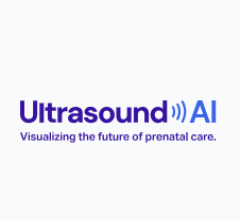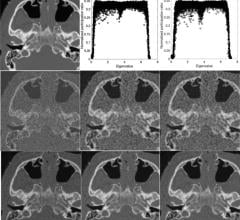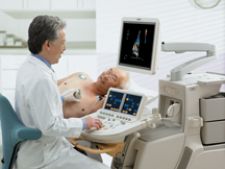
Toshiba's Aplio Artida has the ability to track and display myocardial motion in 3D images.
Heart disease is the leading cause of death of Americans, claiming hundreds of thousands of lives yearly. The ability to diagnose and treat patients sooner and with more accuracy is key to winning the war against heart disease. Advancements in ultrasound — one of imaging technology’s most affordable and available modalities — are leading the charge by bringing enhanced diagnostic and treatment accuracy to more patients.
Having worked in ultrasound for nearly 30 years, Ernesto Salcedo, M.D., associate professor of medicine and director, Echocardiography Laboratory, University of Colorado Hospital, Denver, has witnessed firsthand the technology’s evolving capabilities.
“Lately, I am very excited about the new applications of echo in the cath lab, mainly as a result of its use in interventional cardiology for structural heart disease,” Dr. Salcedo said.
The University of Colorado Hospital has been using 3D real-time (3D/4D) TEE echocardiography, the Philips’ iE33 system, since May 2007, and the technology is now routinely used in their cath lab when percutaneously closing large atrial septal defects. They also use it for alcohol septal ablation on patients with hypertrophic obstructive cardiomyopathy, in patients with mitral stenosis for mitral balloon valvuloplasty and for percutaneous mitral valve repair.
In the OR, Dr. Salcedo believes the technology’s greatest potential is for surgical mitral valve repair. Standard therapy for treating severely impaired heart valves used to involve implanting an artificial valve; now the goal is valve repair versus valve replacement, he says. But, you must be able to determine which valve is repairable. The 3D/4D TEE gives surgeons views of the heart that aren’t possible with two-dimensional data. “Surgeons can now determine - before surgery - which valve is affected and in what area, which in turn, helps them determine the best course of treatment. Intraoperatively, the technology allows the surgeon to immediately see the results of the repair, and provides good information on the evolution of ventricular function.”
Cardiac surgeons were the earliest adopters of 3D ultrasound, said Gordon Parhar, ultrasound business unit director, director of Cardiac Ultrasound with Toshiba America Medical Systems. While many cardiologists were intrigued by 3D echo when it was first introduced, they found it was too time consuming to use in daily practice because of the extra time needed to acquire and then manipulate and review the data. With the technology becoming easier to use and more mainstream, noninvasive cardiologists are realizing that more quantitative data leads to increased diagnostic confidence. 4D can accurately quantify global and regional LV function and severity of regurgitations with reproducible results, he says.
Currently in use in the cath lab and OR, University of Colorado Hospital is also beginning to explore the technology’s use in EP procedures.
“For atrial fibrillation ablation, 3D/4D TEE allows us to see the pulmonary veins in a unique way that wasn’t possible before,” Dr. Salcedo said. In addition, he believes it will aid in atrial flutter ablation and for patients undergoing electric cardioversion where first you must search for the presence of clots in the left atrial appendage, which could lead to stroke during the procedure.
Cardiologist Wolfgang Fehske, M.D., St. Vinzenz Hospital, Cologne, Germany, relies on GE Healthcare’s Vivid S6 cardiovascular ultrasound for applications throughout the hospital.
What makes the Vivid S6 so attractive, he says, is that it is a very small, mobile scanner packed with high-end technology. Although specifically designed as a dedicated cardiovascular solution, it can be used at various locations beyond the cath lab, including the ICU, the EP lab, the OR and for ultrasound-guided procedures at the bedside.
“The Vivid S6 is also completely compatible with the advanced network technology of the GE EchoPAC system, which is the benchmark in digital imaging,” said Dr. Fehske. “It is important to be able to review all prior data on a patient no matter where you are.”
When the hospital used exclusively larger ultrasound units, they performed fewer exams in the ICU and the cath lab. In Dr. Fehske’s experience, Vivid S6’s mobility and networking compatibility are strong arguments for better patient care.
Ultrasound vs. CT, MR
How do the newer features of cardiac ultrasound stack up against the benefits of other imaging modalities?
“Ultrasound is the best modality for frontline, immediate return on diagnostic information,” said John Davidson, senior director, Cardiology, Ultrasound Division, Siemens Medical Solutions.
“Today’s cardiac ultrasound technology offers the benefits of immediate detection and reporting, being able to look at regional wall motion abnormalities in real time and assessment of valve structure and morphology,” Davidson said. Other imaging modalities attempt to acquire these end points, but they accomplish them over a period of time and they require the patient to travel to the source of the imaging whereas ultrasound is transportable to the point of care. As a result, the workflow, costs and turnaround times are much more favorable with ultrasound, he said.
“CT is great for analyzing the coronary arteries and for perfusion, but can’t provide a real-time assessment of heart function,” said Parhar. “With some scanners you can’t see the entire heart and so you have to stitch it together or use some other type of post-processing technique in order to see what’s going on.
“While there is a lot of buzz in the market about CTA, ultrasound is here to stay,” he said. “It’s faster and more cost effective than CT and provides physiological images and data — things that CT cannot, and it does so without any radiation.”
MR tagging has long been considered the gold standard for detecting wall motion abnormalities. But the technology is very expensive, has gating problems and is not always tolerated well by patients. With Johns Hopkins University, Toshiba is trying to validate strain measured by ultrasound against strain measured by MR and will sponsor a JHU symposium on March 29, 2008, where some initial findings on cardiac resynchronization, 2D and 3D wall motion tracking will be presented.
“Echocardiographic wall motion assessment is still largely subjective,” said Parhar. “Toshiba’s goal is to find a quantitative way of determining wall motion abnormalities that may lead to earlier diagnoses. We have developed a wall motion tracking technique that is not subject to angle-dependent Doppler limitations and can detect and quantify wall motion defects that are too subtle to be picked up by the naked eye.
“Detecting myocardial dysfunction in 3D is not a task that is easy to achieve because it generates a lot of data that must be identified and tracked spatially and temporally throughout the cardiac cycle,” said Parhar. Toshiba has developed the Aplio Artida, a new premium system with onboard quantitative tools for LV assessment and resynchronization therapy. Introduced late last summer as a works-in-progress in Europe, the FDA-cleared Aplio Artida will make its U.S. debut at the American College of Cardiology in March.
Getting the “Full” Picture
“Cardiology is all about temporal resolution,” said Davidson. “Ultrasound has prospered in the imaging world because it provides immediate return on diagnostic information in a real-time mode.”
“In order to get full volumes in current 3D or 4D, you have to gate the acquisition, because if you don’t, the volume of data acquired will be very narrow,” explained Davidson.
Siemens is developing an architectural capability, says Davidson, that will enable acquisition of 90-by-90- degree pyramids at 20 volumes/second, every second; in other words, full-volume, true volumetric imaging in real time. This capability is expected to greatly enhance current 3D/4D ultrasound imaging because it eliminates the need for ECG gating. Furthermore, from a full-volume image, users will be able to extract their choice of M-Mode, 2D, 3D or 4D data for their individual diagnostic purposes.
Davidson believes, however, that volumetric ultrasound will not be accepted until and unless there is a fully defined DICOM standard for the file format and the images can be reviewed on regular off-the-shelf PCs. An additional challenge will be the impact on a hospital IT’s infrastructure due to larger file sizes being transported over internal networks. Despite the challenges, Siemens expects to offer full-volume imaging in product form by the end of this year.
“The overall acceptance of 3D/4D and volumetric imaging will be progressive, with the fastest track to acceptance being the technology’s ability to streamline, modify and shorten workflow pathways,” said Davidson.

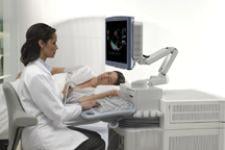
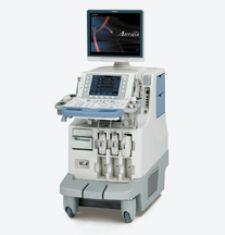
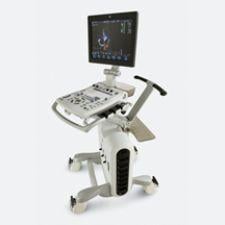

 December 23, 2025
December 23, 2025 







